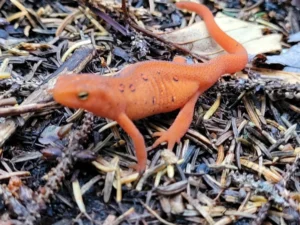Salamanders are soft-skinned amphibians that often live in wet, quiet places. Their gentle appearance and slow movements may seem harmless, but some people wonder whether touching one could be dangerous or even deadly.
No, you can not die from simply touching a salamander, but some species produce toxins that can irritate your skin or cause serious problems if the toxins enter your mouth, eyes, or open wounds.
These toxins are part of their natural defense system. As long as you avoid handling them carelessly and wash your hands afterward, the risk of serious harm is extremely low.
Why Are Some Salamanders Toxic?
Salamanders have thin, sensitive skin that dries out easily. Because they can not run fast or bite hard, they rely on chemical defenses to avoid predators.

Some species produce toxins in their skin that make them unpleasant or dangerous to eat.
These toxins are not meant for humans, but they can still affect us if we absorb or ingest them.
For example:
- Some salamanders have glands that release neurotoxins, which affect nerves or muscles in predators.
- Others produce skin-irritating compounds that cause burning, tingling, or swelling.
- Brightly colored salamanders, such as fire salamanders or newts, are more likely to have strong toxins.
These substances are usually only dangerous if they get into your mouth, eyes, or cuts on your skin.
In general, simply touching a salamander and then washing your hands will keep you safe.
What Happens If You Touch a Salamander?
If you gently touch a salamander and then wash your hands afterward, there is almost no risk.
However, if you:
- Rub your eyes after touching it
- Touch your mouth or eat food without washing your hands
- Have cuts or scrapes on your hands
- Handle toxic species repeatedly
You could experience some mild symptoms such as:
- Itching or burning skin
- Redness or swelling
- Nausea or stomach discomfort (if you accidentally ingest toxins)
- Eye irritation or pain
These symptoms are usually mild and go away quickly with proper care. If
they become severe or do not improve, you should contact a doctor or poison control center.
Are Any Salamanders Deadly to Humans?
There are no known cases of people dying just from touching a salamander. Even the most toxic species are not deadly through skin contact alone. However, some salamanders do carry enough toxins to cause serious health problems if the chemicals are ingested.
For example:
- Rough-skinned newts (Taricha granulosa) carry a toxin called tetrodotoxin. This same toxin is found in pufferfish and is extremely dangerous. If swallowed, even a small amount could be fatal.

However, just holding or touching the newt will not kill you, as long as the toxin does not enter your body through your mouth or broken skin.
Children and pets are more at risk because they are more likely to put their hands in their mouths or try to taste the animal. For this reason, salamanders should never be handled by young children without supervision.
Can You Get Sick From Salamanders?
Yes, in rare cases, people can become sick after handling salamanders, but not because of toxins alone. Some salamanders can carry bacteria or parasites that are harmful to humans.
One of the most common is Salmonella, which can live on a salamander’s skin or in its waste. If this bacterium gets into your body, it can cause:
- Fever
- Diarrhea
- Stomach cramps
- Vomiting
Reptiles and amphibians are both known to carry this bacteria. That is why it is important to wash your hands thoroughly after any contact with salamanders or their enclosures.
What Should You Do After Touching a Salamander?
If you come into contact with a salamander, here are the safety steps you should follow:
- Wash your hands thoroughly with soap and warm water.
- Avoid touching your face, especially your eyes, nose, or mouth.
- Clean any cuts or scrapes that may have touched the salamander.
- Keep food and drink away from salamander enclosures or your hands during handling.
- Supervise children to make sure they do not put their hands in their mouths after touching the animal.
These simple steps will keep you safe from both toxins and bacteria.
Are Salamanders Dangerous to Pets?
Yes, salamanders can be dangerous to dogs, cats, and other pets if eaten or mouthed. Because salamander toxins are designed to stop predators, they can be harmful or even fatal to pets that bite or chew them.

Signs of poisoning in pets may include:
- Drooling
- Vomiting
- Muscle twitching
- Weakness
- Difficulty breathing
If you think your pet has bitten or eaten a salamander, contact a veterinarian right away. Do not wait for symptoms to appear. Even small salamanders can carry enough toxin to cause problems in small animals.
Keep salamanders in secure enclosures where pets cannot reach them.
How Toxic Are Common Pet Salamanders?
Most salamanders that are sold as pets have mild toxins. These are usually not harmful to humans unless misused. For example:
Tiger salamanders have glands that release a sticky, unpleasant substance, but it is not very dangerous.
Axolotls, which live fully underwater, do not produce strong toxins and are generally safe to touch briefly.
Fire salamanders have strong toxins and should be handled with extra care, if at all.
In general, pet salamanders are safe to keep and care for if proper hygiene is followed. Always research the specific species before adopting one.
Why Is Their Skin So Sensitive?
Salamanders have very thin skin that helps them absorb oxygen and water. This makes them vulnerable to:
- Dry air
- Heat
- Chemicals like soap, lotion, or bug spray
- Handling by humans
Touching a salamander with dry or dirty hands can harm the salamander more than it harms you. Their skin absorbs whatever is on your fingers. Even small amounts of salt, oil, or chemicals can cause serious problems.
To protect both yourself and the salamander:
- Only handle salamanders when necessary
- Always wet your hands with clean, dechlorinated water first
- Never wear lotion, sanitizer, or soap on your hands when touching them
- Gently support them without squeezing or poking
Salamanders are better off being observed than handled.
Who Should Avoid Touching Salamanders?
While touching a salamander is not deadly, some people should be extra cautious, including:
- Young children, who may forget to wash their hands
- People with cuts, rashes, or broken skin
- Anyone with a weakened immune system
- People who are sick or already fighting infection
In these cases, it may be better to admire salamanders without handling them at all.
Conclusion
Can you die from touching a salamander? No, you cannot. While some salamanders carry toxins in their skin, these chemicals are not deadly by simple contact.
Most salamanders are safe to observe and even handle briefly, if you wash your hands afterward and take basic precautions.
However, their skin is delicate, and their toxins can still harm pets or cause problems if handled carelessly. Children and animals are more at risk. For these reasons, it is always best to handle salamanders gently, rarely, and responsibly.
Hi, my name is Ezra Mushala, i have been interested animals all my life. I am the main author and editor here at snakeinformer.com.

